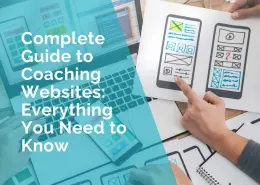8 Useful Tips That Will Put Your Website Ahead Of The Competition
Square buttons, round buttons, flashy buttons … will they match my shoes, my handbag or my tie? Are you stuck in a maze of buttons, headings, bullets, sub-headings and colour schemes? STOP!!!! Take a deep breath and read some practical tips for a professional looking website.
1. Select a colour scheme and stick to it.
If your company has a logo or preferred colours on its stationery that’s a good start. For those of you starting from scratch, choose two or three complementary colours and stick with them – don’t change colours on every page.
The most common colour schemes include:
– Red, yellow and white
– Blue and white
– Red, grey and white
– Blue, orange and white
– Yellow, grey and white.
If you’re not sure what colour scheme to choose, surf the internet and find a website that you like. You can then model your colour scheme on what already exists.
2. Use templates.
Can’t find a website you really like? Another option is to choose a template. There are many templates or pre-set designs. These come as part of your web design software (such as Dreamweaver or Expression Web) or you can check out some websites that specialise in designing templates.
3. Provide an easy to use navigation system.
This is one of the most important issues to consider when designing a website. You need to ensure your visitors can find what they are looking for easily. Most websites either display their navigation bar on the left or at the top. And since most people are used to this type of navigation, it’s best to stick with it. It also helps to include your navigation bar at the bottom of each page to save your visitors from having to scroll back to the top.
4. Don’t go overboard on special effects
Whilst it is ok to have one or two special effects to jazz up your website, spinning graphics and logos often distract your visitor from the content, not to mention they can take too long to download. Your visitors may click away even before your spinning logo finishes loading.
5. Background
Ensure your visitors can read the text on the background, ie. no black writing on dark blue background or yellow on white. Also be careful that your links are visible before and after being visited. The default for links in most programs is blue (before being visited) and burgundy (after being visited), so if you have a dark background, ensure your links are light.
6. External Links
It is a good idea to open links to other websites in a new window. That way your visitors can easily return to your site when they are finished browsing the external link
7. Site Map & Search Feature
If you website is more than 15 pages, it is useful to have a site map or a “Search” feature to ensure your visitors can easily find what they’re looking for.
8. Content is King
While it is important that your website looks clean and professional, it is far more important that you concentrate your efforts on the content and promotion.
If you want a professional website, things to stay away from include:
1. Flash intros, revolving globes, bevelled line separators, animated mail boxes
2. Loads of pop up or pop under boxes
3. Autoplay music. Allow your customer to play music only if they choose.
4. Hit counters of the free variety, which say “you are 27th visitor”
5. Date and time stamps, unless your website is updated daily or weekly
6. Busy backgrounds.
Don’t sweat the small stuff and get yourself focused on what to include on the website and the best way to promote it. We will cover these topics in future articles.
***
by Ivana Katz
Websites 4 Small Business – www.web4business.com.au















